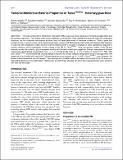Tectorial Membrane Material Properties in Tecta[superscript Y1870C+] Heterozygous Mice
Author(s)
Masaki, Kinuko; Ghaffari, Roozbeh; Gu, Jianwen Wendy; Richardson, Guy P.; Freeman, Dennis M.; Aranyosi, Alexander J.; ... Show more Show less
DownloadMasaki-2010-Tectorial Membrane M.pdf (621.8Kb)
PUBLISHER_POLICY
Publisher Policy
Article is made available in accordance with the publisher's policy and may be subject to US copyright law. Please refer to the publisher's site for terms of use.
Terms of use
Metadata
Show full item recordAbstract
The solid component of the tectorial membrane (TM) is a porous matrix made up of the radial collagen fibers and the striated sheet matrix. The striated sheet matrix is believed to contribute to shear impedance in both the radial and longitudinal directions, but the molecular mechanisms involved have not been determined. A missense mutation in Tecta, a gene that encodes for the α-tectorin protein in the striated sheet matrix, causes a 60-dB threshold shift in mice with relatively little reduction in outer hair cell amplification. Here, we show that this threshold shift is coupled to changes in shear impedance, response to osmotic pressure, and concentration of fixed charge of the TM. In Tecta[superscript Y1870C+] mice, the tectorin content of the TM was reduced, as was the content of glycoconjugates reacting with the lectin wheat germ agglutinin. Charge measurements showed a decrease in fixed charge concentration from −6.4±1.4−6.4±1.4 mmol/L in wild-types to −2.1±0.7−2.1±0.7 mmol/L in Tecta[superscript Y1870C+] TMs. TMs from Tecta[superscript Y1870C+] mice showed little volume change in response to osmotic pressure compared to those of wild-type mice. The magnitude of both radial and longitudinal TM shear impedance was reduced by 10±1.610±1.6 dB in Tecta[superscript Y1870C+] mice. However, the phase of shear impedance was unchanged. These changes are consistent with an increase in the porosity of the TM and a corresponding decrease of the solid fraction. Mechanisms by which these changes can affect the coupling between outer and inner hair cells are discussed.
Date issued
2010-11Department
Harvard University--MIT Division of Health Sciences and Technology; Massachusetts Institute of Technology. Department of Electrical Engineering and Computer Science; Massachusetts Institute of Technology. Research Laboratory of ElectronicsJournal
Biophysical Journal
Publisher
Elsevier
Citation
Masaki, Kinuko, Roozbeh Ghaffari, Jianwen Wendy Gu, Guy P. Richardson, Dennis M. Freeman, and A.J. Aranyosi. “Tectorial Membrane Material Properties in Tecta[superscript Y1870C+] Heterozygous Mice.” Biophysical Journal 99, no. 10 (November 2010): 3274–3281. © 2010 Biophysical Society
Version: Final published version
ISSN
00063495
1542-0086